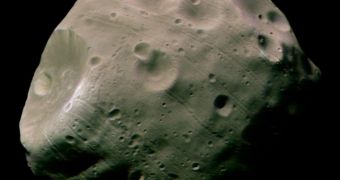Unlike most of the individual celestial bodies in the universe, which tend to take the shapes of spheres (the geometrical object with minimum surface area in relation to volume), asteroids come practically in all the possible shapes and sizes, although why this happens remained largely unknown until now. By studying several thousand different asteroids orbiting through the inner regions of the solar system, researchers at the University of Szeged now believe they have found the answer to a long standing mystery.
"There are several hundred thousand asteroids in our solar system. They orbit the sun, but because they are small their surface gravity is low. This means that many have strange, irregular shapes," said Gyula Szabo of the University of Szeged.
According to one of the theories, roughly one third of all asteroids in the solar system are part of a group of objects created during the collision of much larger objects. Most of the time, data regarding objects such as asteroids comes from spacecrafts that pass through their immediate vicinity, the rest of the work being done by ground-based radio observatories as asteroids approach Earth. But radio observations can only be applied if the respective object is big enough.
Since encounters between spacecrafts and asteroids are relatively rare and the vast majority passing through the vicinity of the Earth are relatively small, it's easy to imagine that information gathering can be rather difficult. Well, things would not be so hard to solve if one used a 'time-resolved photometry' method. Time-resolved photometry basically involves the observation of the variation in the brightness of a body as is tumbles through the emptiness of space. From this data, astronomers can then extrapolate the rough shape of the object being observed.
The Sloan Digital Sky Survey is just one of the missions studying asteroids while at the same time gathering valuable information regarding stars and galaxies in the universe.
"This procedure was very economical. Using photometry, astronomers have determined shapes for about 1,200 asteroids in the past 30 to 40 years. We derived the shapes for ten times more asteroids, but in half an hour! The results were really surprising. We saw there were families that included many elongated asteroids, and there were other ones which consisted of mostly spheroidal bodies," said Gyula.
Groups of asteroids with a wide variety of shapes are most likely to have formed relatively recently from multiple fragments of rock that stuck together, while asteroids with rough spheroidal shapes are usually the oldest, having ages up to 2 billion years. This happens as they are eroded over the years by multiple impacts during their lives.
"The results make sense. Catastrophic impacts create a huge slew of fragment shapes, like the shards of a broken bottle. The debris then are weathered over time and smoothed towards sphericality by small impacts," said impact specialist Jonti Horner of the UK Open University.
"Sometimes astronomers have to be archeologists, too. This work is a fine example of how we can deduce a billion-year process from the world we observe today," said Gyula.

 14 DAY TRIAL //
14 DAY TRIAL //